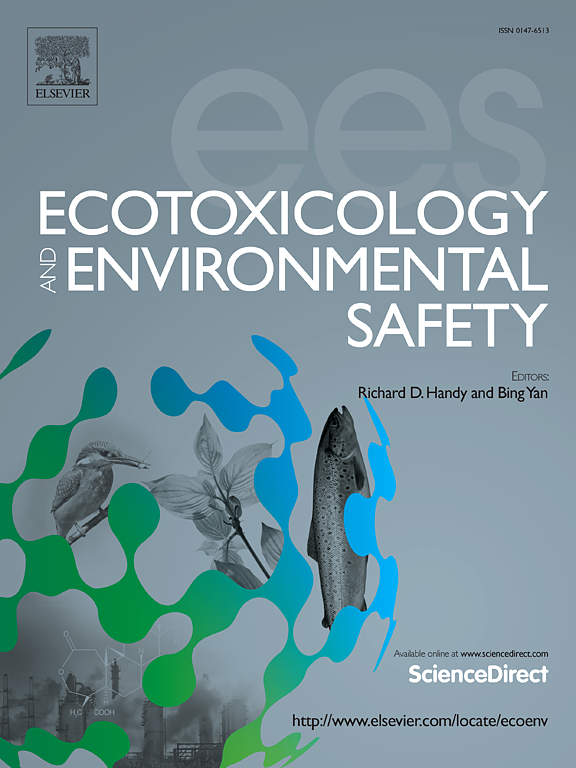多环芳烃和维生素D共同暴露与早期肺功能障碍的关系:代谢评分-内脏脂肪指数的中介作用。
IF 6.1
2区 环境科学与生态学
Q1 ENVIRONMENTAL SCIENCES
引用次数: 0
摘要
背景:保留比肺功能受损(PRISm)和气流阻塞被认为是慢性阻塞性肺疾病(COPD)的关键早期体征。虽然这些疾病是由同时暴露于有毒物质和必需营养素引起的,但维生素D如何改变多环芳烃(PAHs)诱导的肺毒性及其代谢机制尚不清楚。方法:基于2007-2012年国家健康与营养调查(NHANES), 2189名参与者的尿PAH代谢物(ΣOH-PAHs)、血清维生素D代谢物水平[Σ25(OH)D]和肺功能测试[一秒钟用力呼气量(FEV1)、用力肺活量(FVC)和FEV1/FVC]数据,其中包括369名早期肺功能障碍受试者,定义为PRISm或气流阻塞。利用生化标志物计算多种代谢紊乱指标。采用多元线性和逻辑回归模型评价维生素D与多环芳烃的相互作用效应。采用因果中介分析和结构方程模型探讨代谢指标的中介作用。结果:多环芳烃和维生素D对肺功能参数的影响相反[FEV1: β (95 CIs) = -0.01 (-0.02,-0.01)vs. 0.01 (0.01, 0.04);FVC: β (95 CIs) = -0.01 (-0.02,0.01)vs. 0.04(0.01, 0.06)]和早期肺功能障碍风险[OR (95 CIs) = 1.22 (1.06,1.40)vs. 0.52(0.37, 0.73)]。在体重指数(BMI) 2的受试者中,随着Σ25(OH)D的增加,ΣOH-PAHs与FEV1、FVC和早期肺功能障碍以及代谢评分-内脏脂肪指数(MSV)的相关性降低。此外,共同暴露于ΣOH-PAHs和Σ25(OH)D与FEV1、FVC、FEV1/FVC和早期肺功能障碍疾病的关联中,有2.18% %、18.20 %、5.70 %和4.70 %由MSV介导。结论:我们的研究结果表明,维生素D通过代谢改变拮抗多环芳烃对早期肺功能障碍的有害影响,为识别潜在的高危人群和减轻多环芳烃诱导的肺功能障碍提供了新的见解。本文章由计算机程序翻译,如有差异,请以英文原文为准。
Associations of co-exposure to polycyclic aromatic hydrocarbons and vitamin D with early lung dysfunction: Mediating roles of metabolic score-visceral adiposity index
Background
Preserved ratio impaired spirometry (PRISm) and airflow obstruction are recognized as critical early signs of chronic obstructive pulmonary disease (COPD). While these conditions arise from concurrent exposure to toxicants and essential nutrients, how vitamin D modifies the pulmonary toxicity induced by polycyclic aromatic hydrocarbons (PAHs) and the metabolic mechanisms involved is still unclear.
Methods
Based on the National Health and Nutrition Examination Survey (NHANES) 2007–2012, data on urinary PAH metabolites (ΣOH-PAHs), serum vitamin D metabolite levels [Σ25(OH)D], and pulmonary function tests [forced expiratory volume in one second (FEV1), forced vital capacity (FVC) and FEV1/FVC] from 2189 participants, including 369 subjects with early lung dysfunction, defined as PRISm or airflow obstruction. Multiple metabolic disorder indicators were calculated using biochemical markers. The interaction effects between vitamin D and PAHs were evaluated using multiple linear and logistic regression models. Causal mediation analyses and structural equation modeling were employed to investigate the mediating roles of metabolic indicators.
Results
PAHs and vitamin D had opposite effects on lung function parameters [FEV1: β (95 CIs) = -0.01 (-0.02, −0.01) vs. 0.01 (0.01, 0.04); FVC: β (95 CIs) = -0.01 (-0.02, 0.01) vs. 0.04 (0.01, 0.06)] and risk of early lung dysfunction [OR (95 CIs) = 1.22 (1.06, 1.40) vs. 0.52 (0.37, 0.73)]. Decreased associations of ΣOH-PAHs with FEV1, FVC, and early lung dysfunction, as well as with metabolic score-visceral adiposity index (MSV) were visualized with increased Σ25(OH)D among subjects with body mass index (BMI) < 28 kg/m2. Furthermore, 2.18 %, 18.20 %, 5.70 %, and 4.70 % of the associations of co-exposure to ΣOH-PAHs and Σ25(OH)D with FEV1, FVC, FEV1/FVC, and early lung dysfunction disease were mediated by MSV.
Conclusions
Our findings indicated that vitamin D antagonizes the hazardous effects of PAHs on early lung dysfunction by metabolic alteration, providing new insight into the identification of the underlying high-risk populations and accessible prevention and intervention measures for attenuating PAH-induced lung dysfunction.
求助全文
通过发布文献求助,成功后即可免费获取论文全文。
去求助
来源期刊
CiteScore
12.10
自引率
5.90%
发文量
1234
审稿时长
88 days
期刊介绍:
Ecotoxicology and Environmental Safety is a multi-disciplinary journal that focuses on understanding the exposure and effects of environmental contamination on organisms including human health. The scope of the journal covers three main themes. The topics within these themes, indicated below, include (but are not limited to) the following: Ecotoxicology、Environmental Chemistry、Environmental Safety etc.

 求助内容:
求助内容: 应助结果提醒方式:
应助结果提醒方式:


